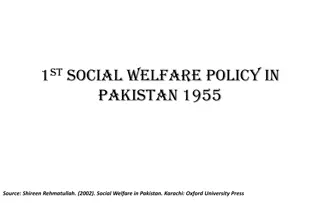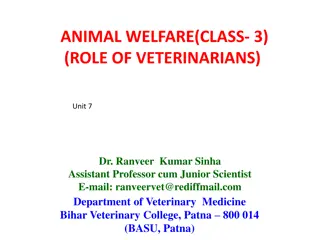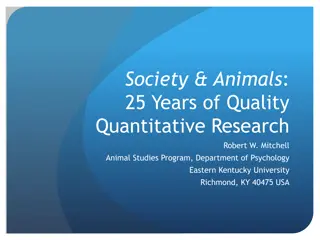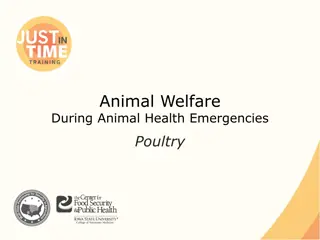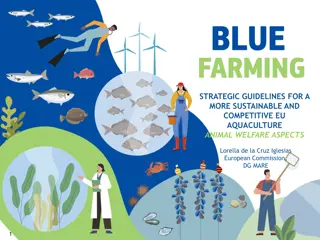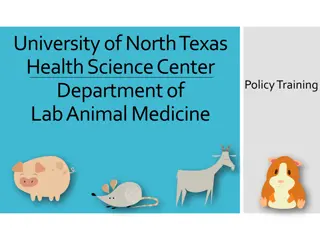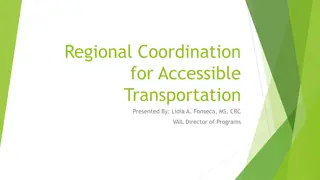Animal Welfare During Transportation - Guidelines and Regulations
Ensuring the welfare of animals during transportation is crucial to their health and safety. Guidelines dictate the separation of different animal classes, restrictions on transporting sick or troublesome animals, and limitations on the number of animals per vehicle. Specific rules exist for transporting cattle, equines, sheep, and goats by rail or vehicle, with maximum limits set for each type. Any violation of these regulations is considered illegal and can result in penalties. The welfare of animals during transportation is overseen by established laws to protect their well-being throughout the journey.
Download Presentation

Please find below an Image/Link to download the presentation.
The content on the website is provided AS IS for your information and personal use only. It may not be sold, licensed, or shared on other websites without obtaining consent from the author.If you encounter any issues during the download, it is possible that the publisher has removed the file from their server.
You are allowed to download the files provided on this website for personal or commercial use, subject to the condition that they are used lawfully. All files are the property of their respective owners.
The content on the website is provided AS IS for your information and personal use only. It may not be sold, licensed, or shared on other websites without obtaining consent from the author.
E N D
Presentation Transcript
ANIMAL WELFARE(CLASS-9) (WELFARE OF ANIMALS DURING TRANSPORTATION) Dr. Ranveer Kumar Sinha Assistant Professor cum Junior Scientist E-mail: ranveervet@rediffmail.com Department of Veterinary Medicine Bihar Veterinary College, Patna 800 014 (BASU, Patna)
GENERAL WELFARE OF ANIMALS DURING TRANSPORTATION Fitness of animal New born, diseased, blind, emaciated, lame, fatigued or having given birth during the preceding seventy two hours or likely to give birth during transport shall not be transported. Pregnant and very young animals shall not be mixed with other animals during transport.
WELFARE OF ANIMALS DURING TRANSPORTATION Different classes of animals shall be kept separately during transport. Diseased animals, whenever transported for treatment, shall not be mixed with other animals Troublesome animals shall be given tranquilizers before loading during transport only 6 large animals in a lorry can be transported. Any violation of these laws is termed illegal. The permissible loading in a truck is only 4 buffaloes or 40 sheep/goats, and shall not carry more than five cattle without calves or four with calves. In the case of trucks whose wheel base is over 142 inches shall not carry more than six cattle without calves or five with calves. Animals in tempo are not allowed. Transport of Animals, Rules, 1978. Transport of Animals (Amendment) Rules, 2009.
TRANSPORT OF CATTLE When cattle is to be transported by rail an ordinary goods wagon shall carry not more than ten adult cattle or fifteen calves on broad gauge Not more than six adult cattle or ten calves on meter gauge Not more than four adult cattle or six calves on narrow gauge. While transporting cattle by goods vehicle, only six cattle should be loaded.
TRANSPORT OF EQUINES By rail, ordinary goods wagon shall carry not more than eight to ten horses or ten mules or ten donkeys on broad gauge Not more than six horses or eight donkeys on meter- gauge. If equines are to be transported by good-vehicles each vehicle should not carry more than four to six equines. For the transport of equines by sea, horses may normally be accommodated in single stalls and mules in pens, each pen holding four to five mules.
TRANSPORT OF SHEEP AND GOATS Broad Guage If the area of wagon is less than 21.1 Square Meters number of sheep or goat allowed is 70 Meter Guage If the area of wagon is 21.11 square Meters and above number of sheep or goat allowed is 100 Narrow Guage If the area of Wagon less than 12.5 Square Meters the number of sheep or goat allowed is 50 If the area of wagon is 12.5 Square Meters and above the number of sheep or goat allowed is 60 Goods vehicle of capacity of 5 or 4.5 tons, which are generally used for transporting animals, shall not carry more than forty sheep or goats.
TRANSPORT OF POULTRY BY RAIL, ROAD AND AIR Kind of Poultry Number in a standard container Month old chickens 24 Three-month old chickens 12 Adult stock(excluding geese and turkeys) 12 Geese and turkeys 10 youngs, 2 growings, 1 grown up Chicks 80 Poult 60
TRANSPORT OF PIGS BY RAIL OR ROAD By road, good vehicles shall not carry more than 20 pigs. Broad Gauge If the area of wagon is less than 21.1 Square Meters number of pigs allowed is 35 Meter Gauge If the area of wagon is more than 21.1 Square Meters number of pigs allowed is 50 Narrow Gauge If the area of wagon is less than 12.5 Square Meter number of pigs allowed is 25 If the area of wagon is more than 12.5 Square Meter the number of pigs allowed is 30 Overloading of animals treated as animals cruelity under Section 11 of The Prevention Of Cruelty to Animals Act,1960.
ANIMAL WELFARE DURING NATURAL CALAMITIES AND DISASTER MANAGEMENT Safety of pets during storms Thunderstorms easily frighten many dogs that might dig or jump from the yard to escape pets are confined safely indoors. Turn on the TV or a radio to help drown out scary noises. Make sure pets have water, bedding and favorite toys. Recommends a microchip complemented by a collar and I.D. tag for identification. The I.D. tag should include two telephone numbers, such as a home number and a work pets that suffer from storm anxiety, the symptoms can include biting, excessive chewing, hiding, pulling out own hair and shaking. Some breeds of dogs are more prone to chronic anxiety namely Bull dogs, German Shepherd, Dalmatians and most breeds of terriers. Never leave animals tied up outside.
DISASTER PREPAREDNESS FOR LIVESTOCK OWNERS EVACUATE LIVESTOCK WHENEVER POSSIBLE. If evacuation is not possible, a decision must be made whether to move large animals to available shelter or turn them outside. Your disaster plan should include a list of emergency phone numbers for local agencies that can assist you if disaster strikes including your veterinarian, local animal shelter etc.









